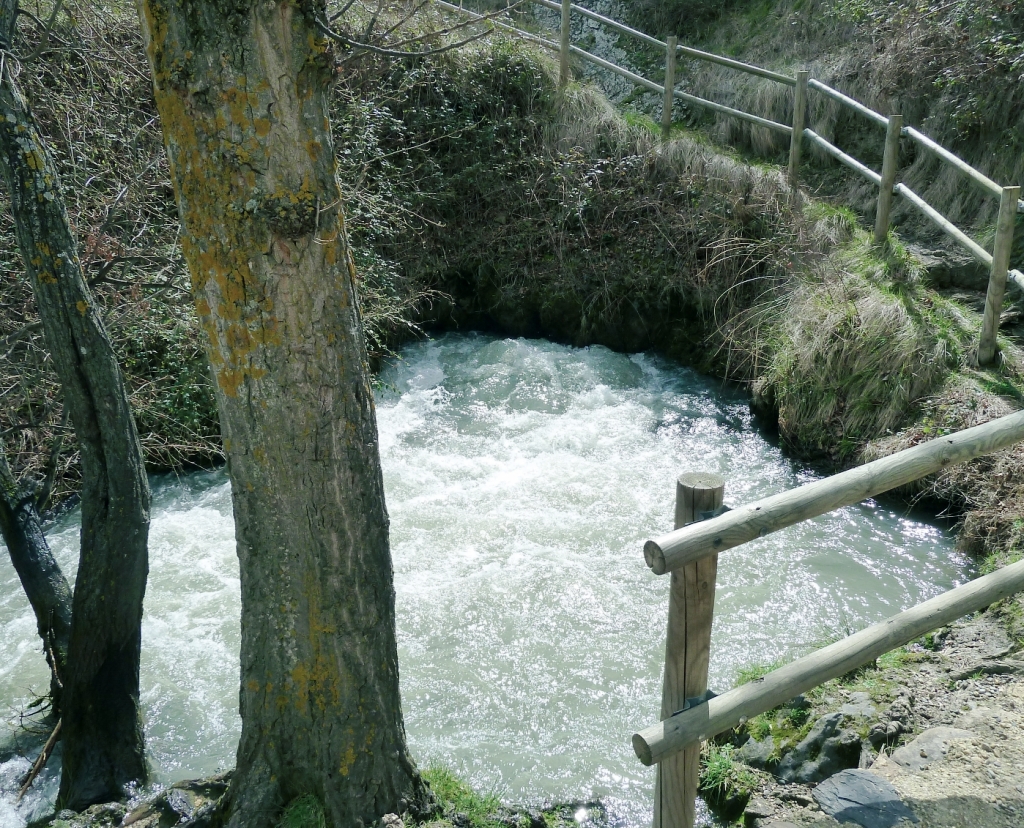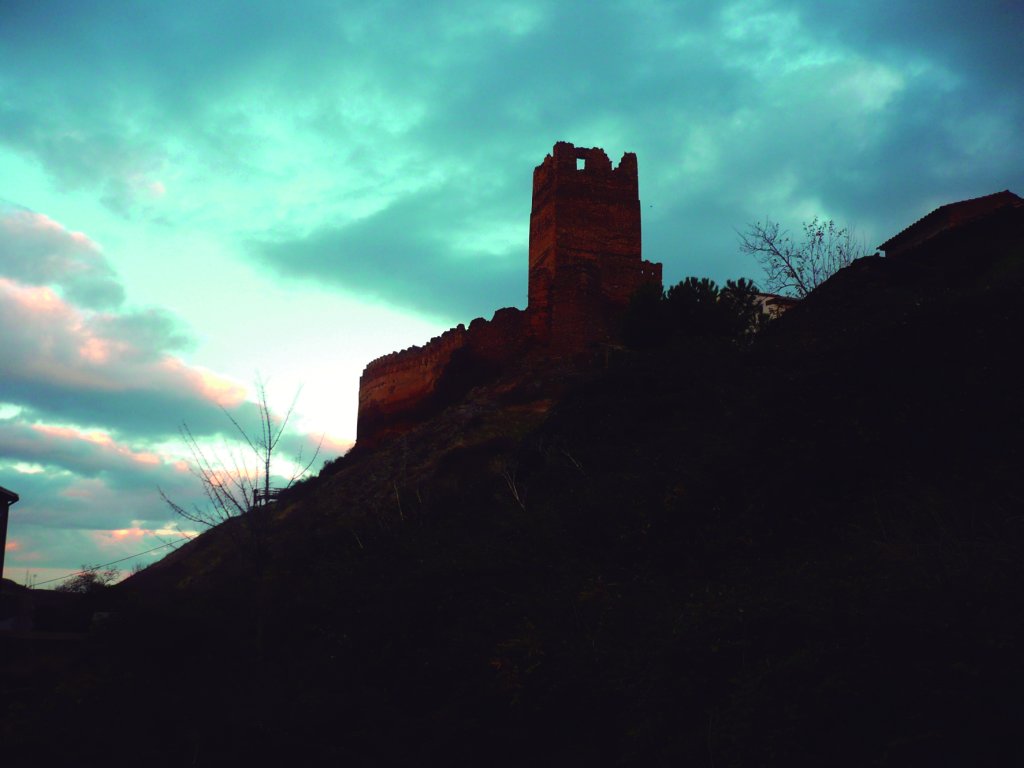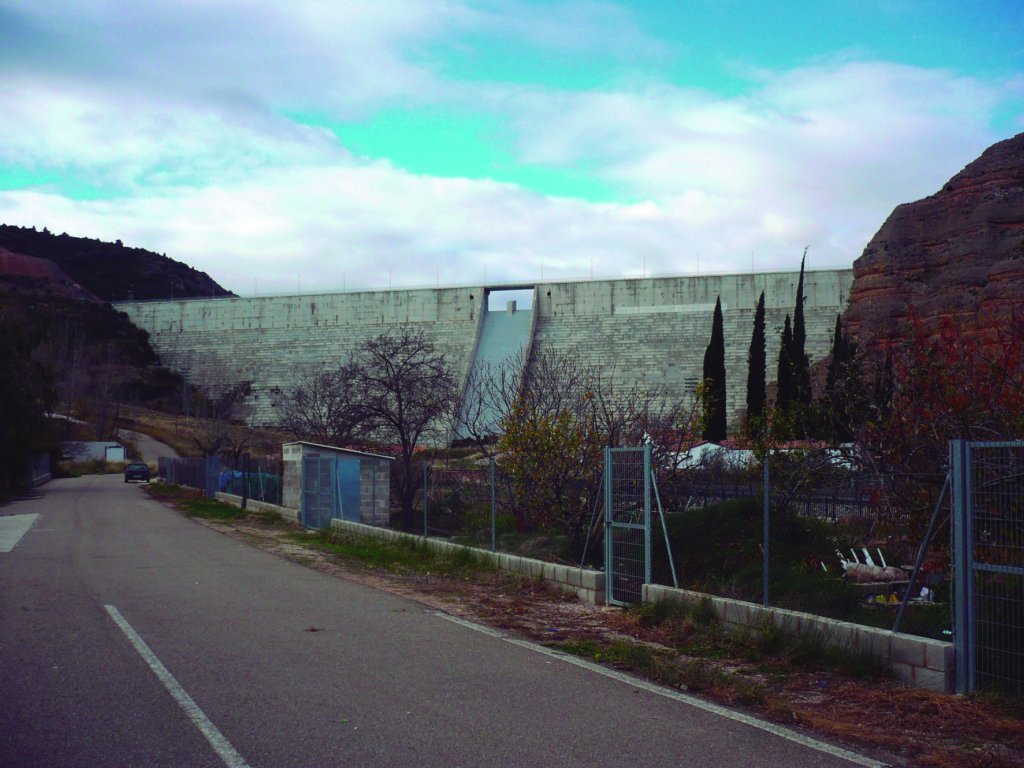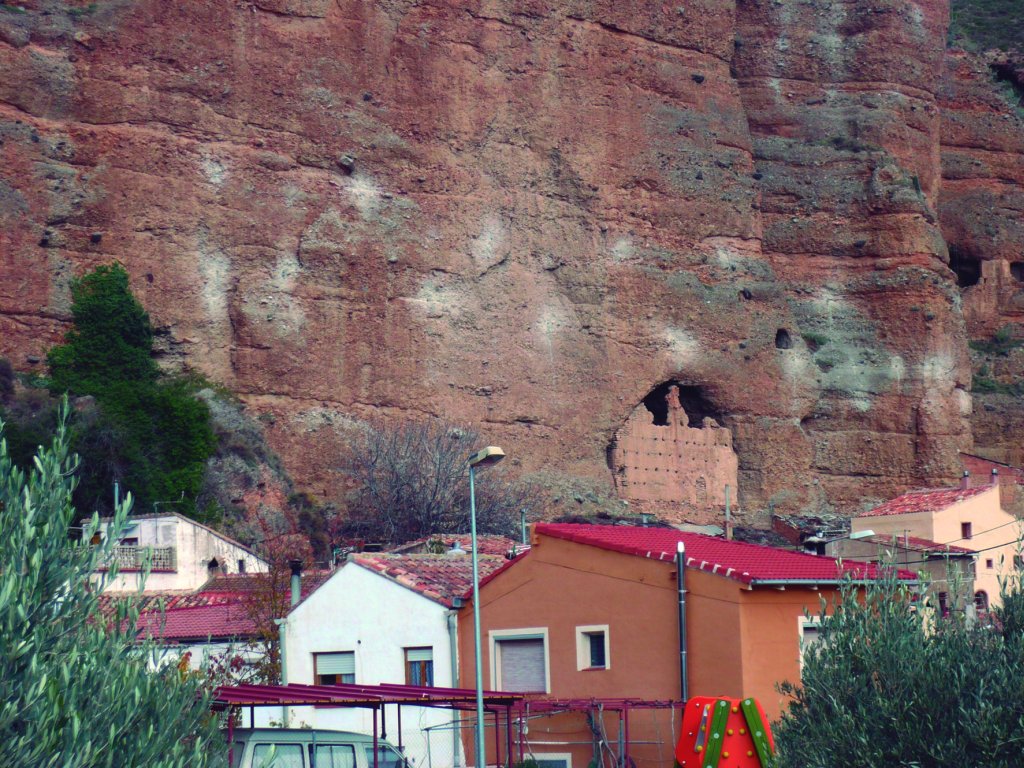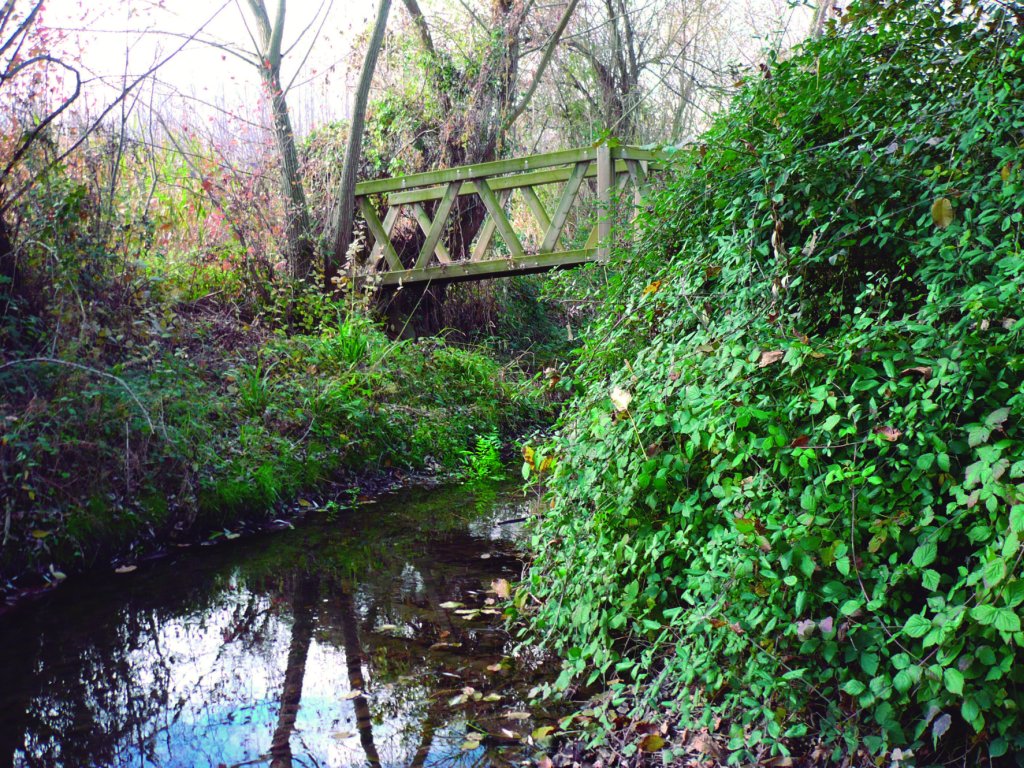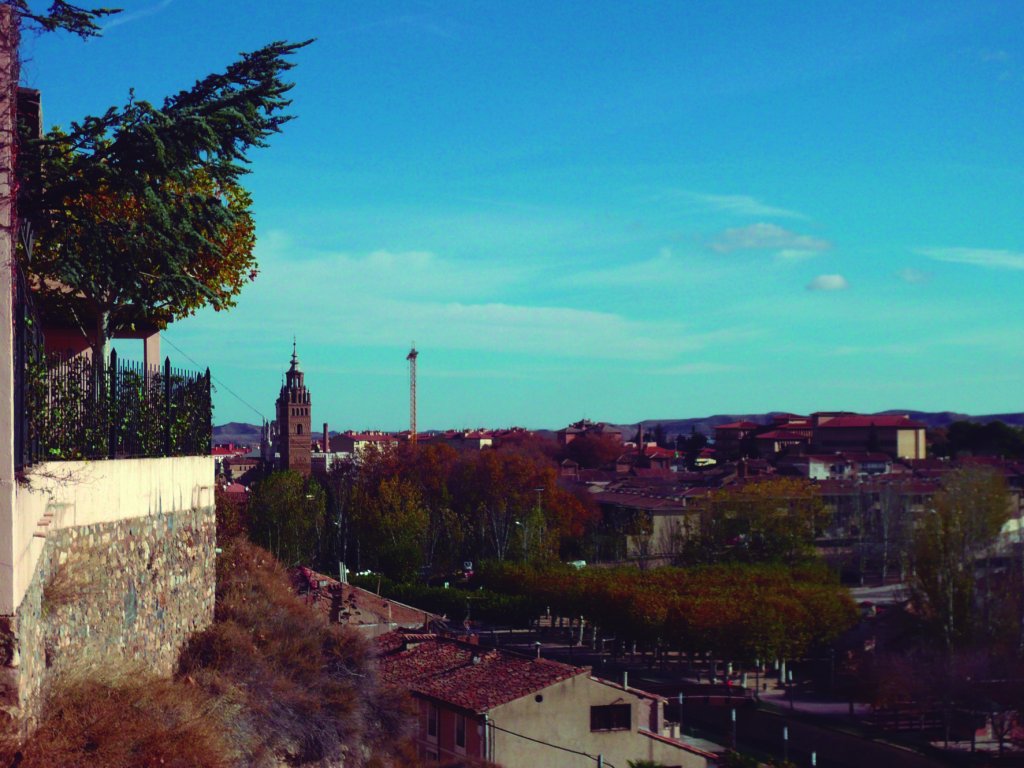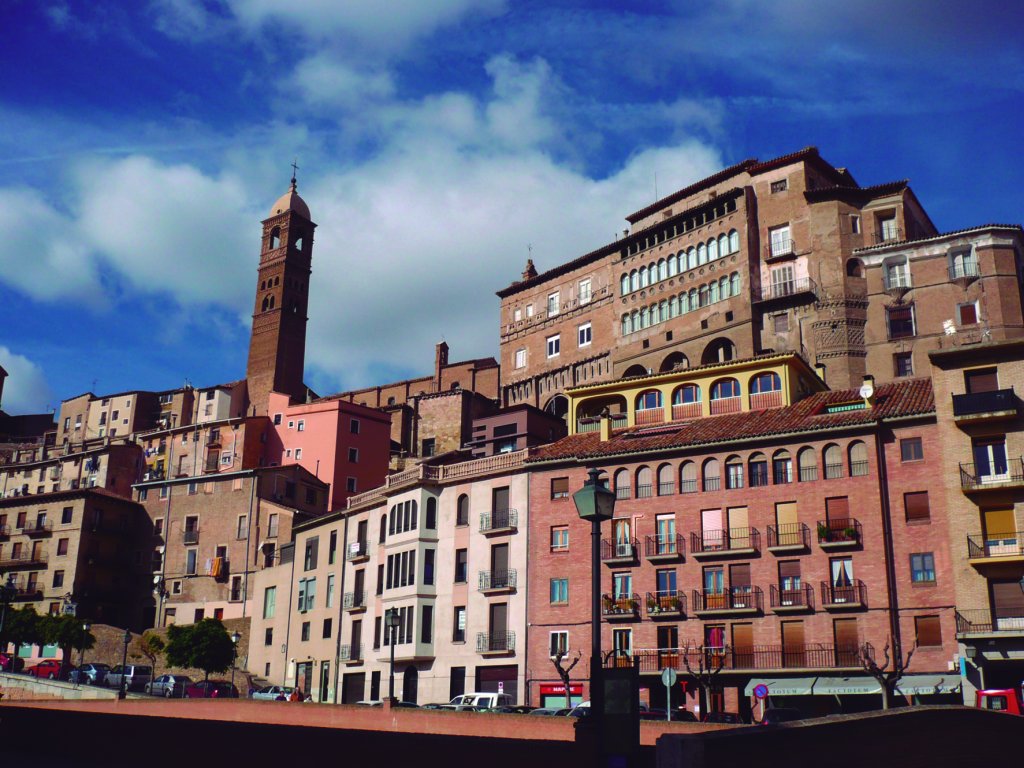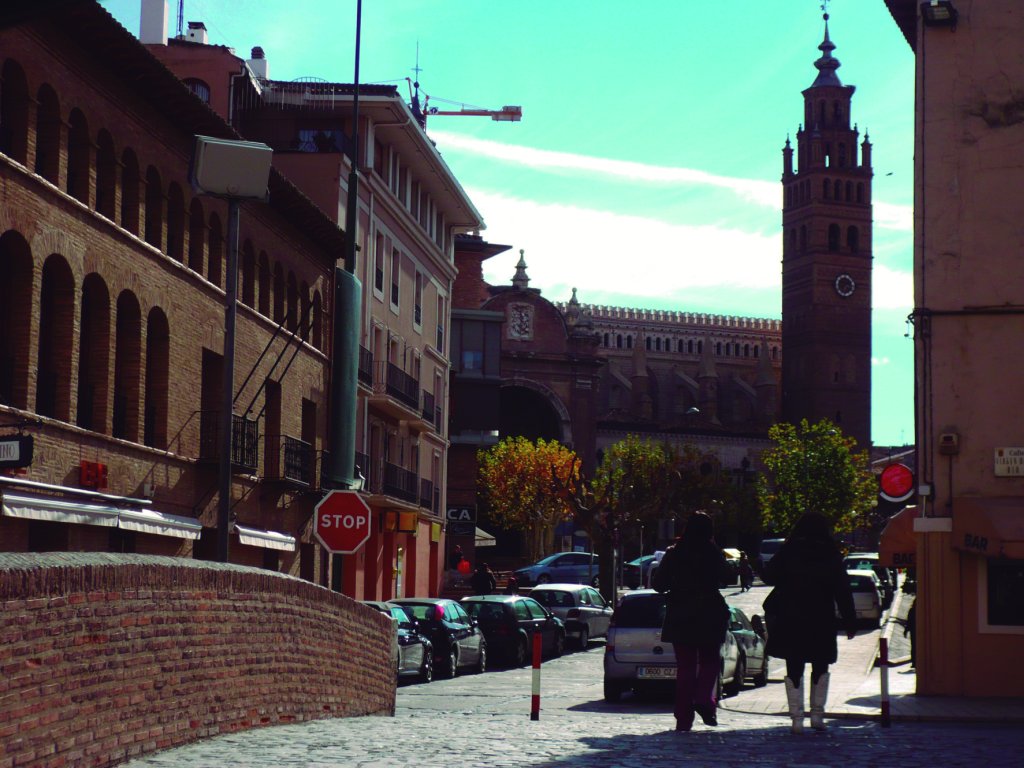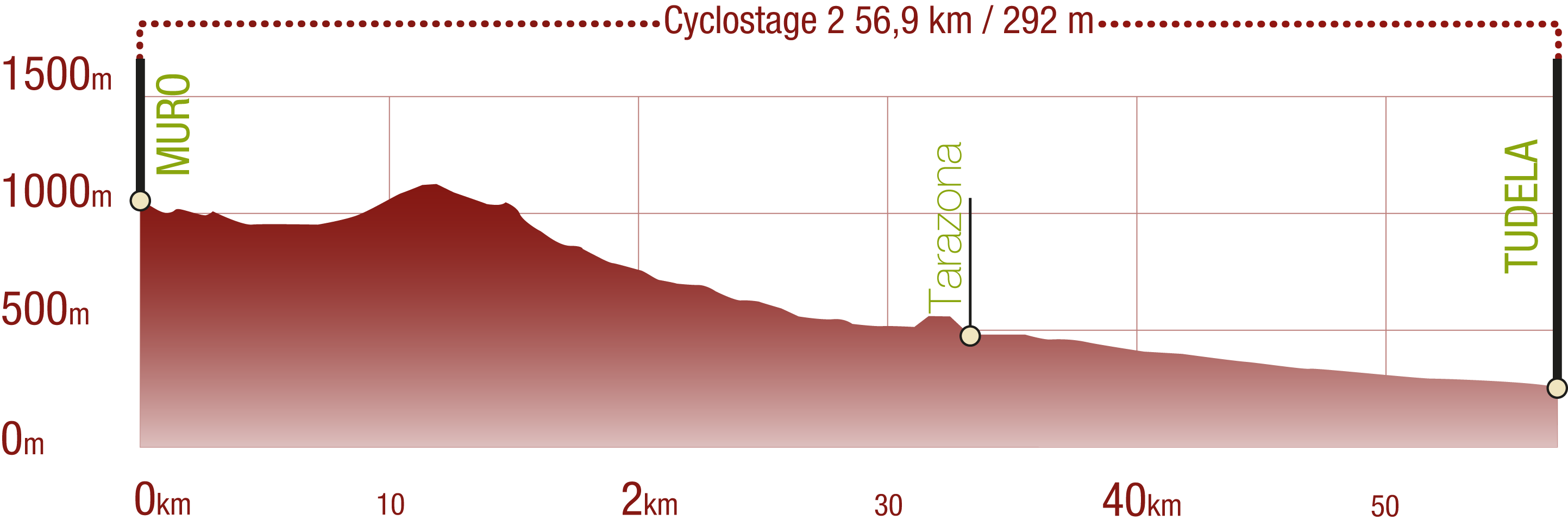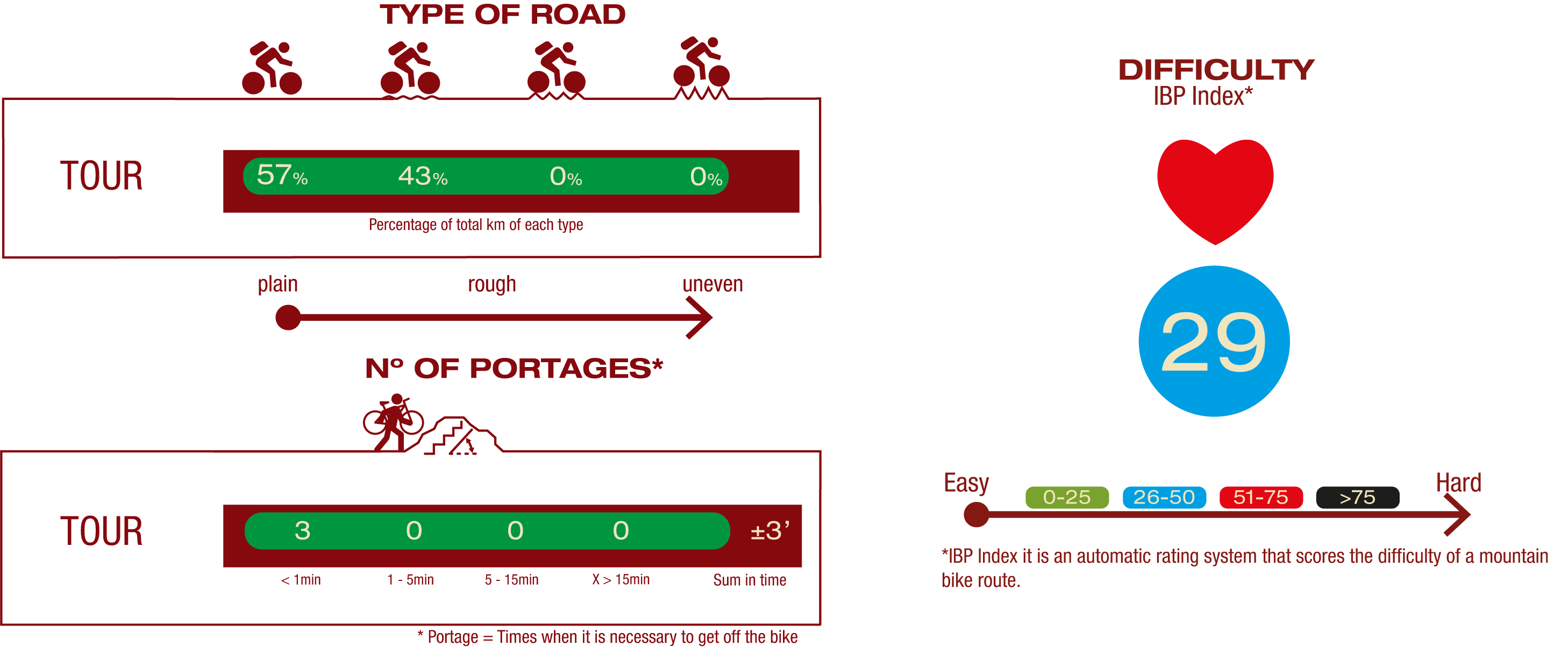- Home
- Rural Development
- Nature Trails
- Nature Trails
- Central Sector
- Agua Soriano. Camino Antonino
Stage 5: Vozmediano - Tarazona
Description

The River Queiles
Through the beautiful landscapes of County Moncayo, the fifth stage of the Agua Soriano Nature Trail leaves behind the province of Soria, following the course of the River Queiles. It ventures into Saragossa, along an 18-kilometre route that starts in Vozmediano, traverses Los Fayos and Torrellas, and ends in the monumental city of Tarazona.
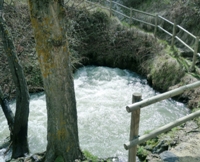
Vozmediano is a beautiful city located in the foothills of the Moncayo, surrounded by small vegetable gardens where local residents grow peppers, tomatoes, artichokes and a variety of fruits. There are also vineyards, which in recent times produced high-alcohol red wines similar to the Aragonese wine. The fifth section of the Agua Soriano-Camino Antonino Nature Trail begins in this town, on the banks of the Queiles, and between the power plant and the fish farm.
Apart from the spectacular headwater of the River Queiles, Vozmediano is surrounded by a richly diverse natural environment populated with pines (Pinus sylvestris), common oaks (Quercus robur), holm oaks (Quercus ilex), walnuts (Juglans regia), poplars (Populus nigra), willows (Salix sp.), holly (Ilex aquifolium), blackberry (Rubus fruticosus) and hawthorn (Crataegus monogyna). The undergrowth consists of aromatic herbs such as lavender (Lavandula angustifolia), which was formerly distilled, thyme (Thymus vulgaris) and rosemary (Rosmarinus officinalis).
Big and small game also populates this area, including rabbits (Oryctolagus cuniculus), wild boar (Sus scrofa), hares (Lepus europaeus), roe deer (Capreolus capreolus), partridges (Alectoris rufa) and pigeons (Columba palumbus).
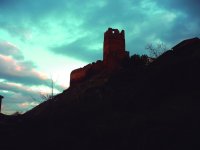
Vozmediano is not only home to the headwater of the River Queiles, but also a border city that played an important historical role in the Middle Ages. Since its conquest in the twelfth century by King Alphonse I of Aragón and until the agreement on boundaries between Castile and Aragón was signed in 1437, the city was involved in the wars between the two kingdoms, changing hands several times, and used even as a bargaining chip in commercial transactions.
The church of Nuestra Señora del Puerto, with Gothic elements, is located in the city centre. The ruins of the shrine of San Sebastián still stand in the fields of El Santo. In bygone days, the city was an industrial hub, with two flour mills, a fulling mill and a mill that made paper for rolling tobacco. There are also a fish farm and three hydroelectric plants on the River Queiles.
At about 800 m after leaving Vozmediano behind via the road to Agreda, the route turns onto the Camino del Queiles. It continues along this road for a little over five kilometres, past the former hydroelectric plants, until it reaches an intersection. Further 700 m down this road is the town of Los Fayos in Aragonese land.
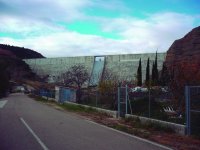
Los Fayos
The town of Los Fayos is located in Somontano del Moncayo, on the banks of the River Queiles, at the foot of a “mallo” or rock walls that often dot the landscape of the region. Los Fayos is only six kilometres from Tarazona. Its origin may have been a former Benedictine monastery from the fourteenth or fifteenth century. It housed San Atilano, the patron saint of Tarazona, whose head was preserved in the town for several years.
Los Fayos, located in a predominantly agricultural area, is nestled against the vertical wall of a cliff, atop which still stand the remains of a twelfth-century castle. The rock wall is dotted with fissures and caves where a large colony of native vultures (Gyps fulvus) has taken shelter. Prominent among these caves, owing to its size, is the famous Cueva del Caco, formerly used as a granary. This cave is the subject of many legends in the Moncayo region.
Besides the famous refuge of Caco, there is another cave, now closed with a brick wall, which housed the 9th-10th century Monastery of San Benito. However, the present-day building is from the eighteenth century. Both the sanctuary and the small sacristy were carved into the rock.
The historical centre of Los Fayos contains a monumental complex that includes the parish church of Santa María Magdalena, built in the sixteenth century, and which still preserves its rich ornamental interior, sculpted in 1575 by the Tarazona sculptor Bernal del Fuego. The eighteenth century tower is in the neomudejar style. Also noteworthy is the palace of the Dukes of Villahermosa, from the seventeenth century, is a three-storey, brick building that retains the sturdiness of Renaissance and baroque Aragonese houses. It is said that King Philip IV spent the night here.
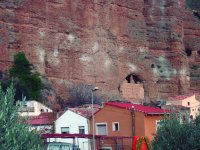
The natural environment of Los Fayos
The municipality of Los Fayos has a natural environment of great ecological value, included two protected areas. One is the course of the River Val and its reservoir, designated a Wildlife Refuge. The Val Reservoir was built near the town in 1996 to catch the waters of the rivers Val and Queiles. Despite its human-made origin, it has become an important area for watching waterfowl, such as ducks (Anatidae), cormorants (Phalacrocorax sp.) and herons (Ardeidae).
The other protected area is Sierra del Moncayo-Los Fayos-Sierra de Armas, designated a Special Protection Area for Birds (SPA). More than 80 bird species of “special interest” included in the National Catalogue of Endangered Species have been identified in this geographical area, rock-dwelling raptors being the most abundant.
The abundance of raptors in the natural environment of Los Fayos, including vultures, ospreys (Gypaetus barbatus), Egyptian vultures (Neophron percnopterus) and falcon hawks (Falco peregrinus), has been the inspiration behind the Falconry Museum located in the former jail. This museum brings greater understanding of the techniques and animals involved in this sport, regarded as an art since ancient times, both in terms of the skill of the falconer and the beauty of the birds. A Falconry Fair has taken place since 2004 with various displays.
It is also interesting to note the proximity of Los Fayos to Dehesa del Moncayo Nature Park, and to Veruela Monastery, located in Vera de Moncayo. Both places have various museums and interpretation centres that bring a deeper understanding of the surrounding environment.
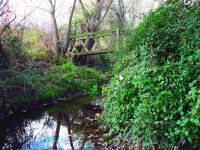
Torrellas
At the edge of Los Fayos, next to the old school, the route heads down a track or path that runs along the left bank of the River Queiles until it meets the road between the river and the road to Torrellas. This road passes close to this town, which warrants a detour from the Nature Trail.
Torella's architecture can be discovered while strolling through its quiet streets. The main square, where a market used to be held, is a landmark of this town. It is an arcaded square, with stone mansions and trabeated porches, prominent among which is the sandstone façade of the Casa de la Villa, former residence of the Dukes of Villahermosa.
The parish church of San Martín de Tours, built over the lower level of a former mosque, can also be found in the town centre. The temple was renovated in the seventeenth century and turned into a Christian place of worship. It has a beautiful Moorish style octagonal tower. This town is home to the La Huella del Islam interpretation centre, dedicated to the legacy left in the region by the Moors before their expulsion from the Iberian Peninsula. The remains of a castle, of which only the keep still stands, and an eighteenth century former hospital can also be found in Torrellas.
Further on the Nature Trail, following the path that runs between the River Queiles and Los Fayos-Torellas road, is a milestone where the path turns onto the road to Tarazona.
On the edge of the city, a path to the south leads down to the river. The route continues along a track that runs through a ravine, then joins the N-122, which it crosses, to continue northeast towards the road to La Salve. After travelling one kilometre to the east, it meets a path that skirts around the cemetery along the south and enters Tarazona.
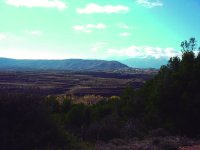
Tarazona
Tarazona sits halfway up the Queiles River Valley, in the foothills of the Moncayo. Tarazona and its county are one of the areas in Aragón with the richest natural heritage. In merely 20 kilometres, the altitude increases nearly 2,000 m. This allows for a variety of environments and landscapes, from beech groves typical of Atlantic and Euro-Siberian regions to steppe and semi-arid areas.
The history of Tarazona was not documented until Roman times. However Celtiberian coins and other remains found in the area suggest that there used to be a Celtiberian settlement that the Romans later called Turiaso. According to legend and the coat-of-arms of the city, ancient Turiaso was built by Tubalcaín and rebuilt by Hercules.
The footprint of the Celts, Romans, Visigoths, Muslims, Jews and Christians is evident in the rich artistic heritage of Tarazona, capital of the counties of Tarazona and Moncayo. The streets of the old town were declared a Historic Artistic Monument in 1965. It still preserves the footprint of by-gone days when the latter three cultures co-existed during the Middle Ages and Modern Age. Not surprisingly, Tarazona is known for its rich Moorish heritage, one of the best preserved in Aragón.
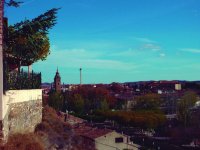
In addition to its wealth of medieval architecture, there are also Renaissance palaces, churches and convents of different ages and styles, as well as important buildings such as the Cathedral of Santa María de la Huerta, the former market, present-day city hall, the Episcopal Palace, the former bullfighting ring and the Theatre of Fine Arts.
The Cathedral of Santa María de la Huerta, designated a Site of Cultural Interest in 2002, is a true mosaic of architectural styles, a building where the purest French Gothic style, coexists with Mudejar and Renaissance. It was built in the French Gothic style. The clerestory, which rises halfway up the transepts and extends across the entire chapel, has thirteenth century Romanesque capitals supporting small Gothic arches. This is one of the most primitive examples of peninsular Gothic, not found in any other cathedral in Aragón. The Mudejar elements found in the gallery and on the roof of the main nave date from the late fifteenth and early sixteenth century. Mudejar master masons extended the transept, built the bell tower and renovated the cloister and the dome, which was replaced in the mid-sixteenth century, when the interior of the cathedral was renovated in Renaissance style.
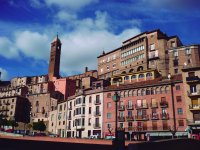
Tarazona City Hall is another important monument of the city. The City Hall, built next to the wall in the sixteenth century, was the marketplace in the Plaza Mayor or Plaza del Mercado. It has an arcaded gallery, or “oxen viewing balcony” from where the members of the city council watched the bullfights and religious events. The façade has a unique sculpted decoration. It is divided by a carved plaster frieze depicting Charles V's procession in Bologna following his coronation as emperor of the Holy Roman Empire.
In 1386, Pedro Bishop Pérez Calvillo ordered the construction of the Episcopal Palace, also known as Alcázar de Hércules. The building was completed in the sixteenth century under the episcopate of Juan González de Munébrega, who ordered the addition of the grand corridor projecting over the rock overlooking the River Queiles, supported by huge brick arches. The Renaissance elements of its façade and courtyard, the dome of the grand staircase and the Bishop's parlour are the work of the Lombard sculptor Pietro Morone, who settled in Moncayo in 1551. Today, the building houses the Centre for Tarazona Studies, with the permanent exhibition "Moncayo Archaeology".
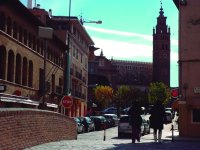
The octagonal Plaza de Toros Vieja from the late 18th century, and the 30 houses that surround it, form a unique ensemble that has been declared a Monument of Tourist Interest. Other civil monuments are the Casa de Linares, example of a 16th century Mudejar-style manor, the palace of Gil de Borja, with an 18th century baroque façade, and the walls of the city. The 16th century palace and garden of Eguarás, and the Theatre of Fine Arts (1921) are other fine examples of civil architecture. The famous “hanging houses”, built over the brick corbels of 16th century buildings, can be found protruding over the Jewish quarter.
The city has several convents, most notably La Merced, built in the fifteenth century by Mercedarian friars that settled in Tarazona. The Bishop gave the friars part of the land on which the old parish church of Santa Cruz del Rebate had stood until its destruction during the War of the Two Pedros. The building is located next to the Plaza del Mercado, in the heart of the city. It was renovated in the late sixteenth century and expanded into the houses which bordered the convent's estate. The new temple, as it is today, contains a valuable eighteenth century altarpiece.
The former convent of San Francisco was established in 1270. However, tradition holds that it was Saint Francis of Assisi himself who, during his visit to Tarazona in 1214, established a small community of Friars Minor. The Bishop and the cathedral chapter donated the shrine of San Martín as an oratory. Following the confiscation of 1835, the Franciscan temple became the Sancti Spiritus municipal hospital. Most of the rooms were demolished in the twentieth century, and the church became a parish.
Profile
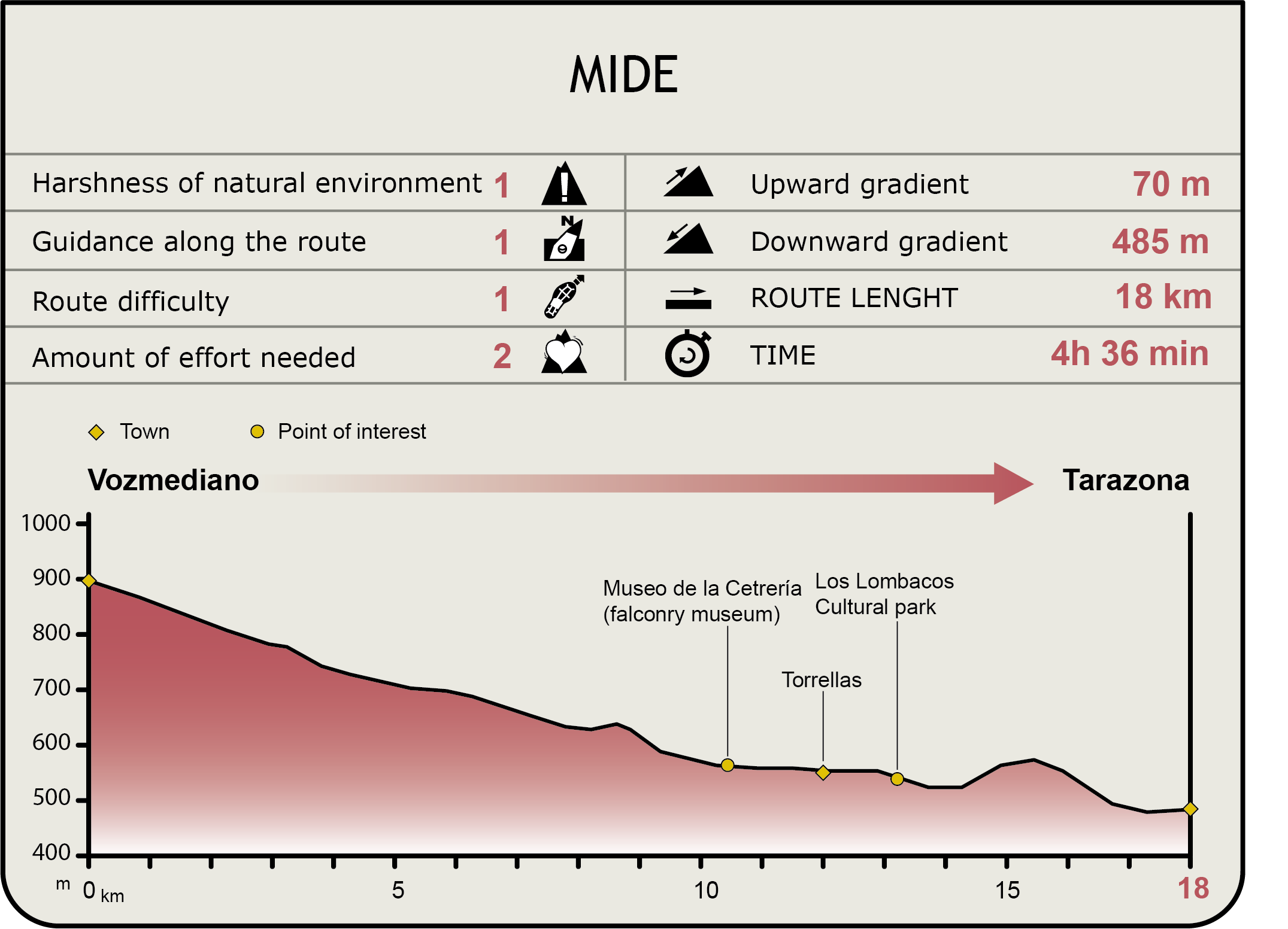
MIDE (Method for the Information of Excursions)
Featured
Further information
Vozmediano Castle
To the southwest of Vozmediano, at an altitude of about 1,000 m, stands the castle of Vozmediano on a cliff overlooking the town, in the place where the second branch of the River Queiles rises. This castle is tightly bound to the medieval history of the town. It was used as a bargaining chip by Castilians and Aragonese alike during the border feuds. The castle was attacked both by Navarre and Aragonese troops in different periods, changing hands quite often. It is currently the municipal cemetery.
However, the castle is not of medieval origin. The inner enclosure may have been Roman, while the exterior and the keep may have been Arab. There is no evidence that it took part in the reconquest of the border along the Douro, and it was not until the twelfth century when its existence was first documented. It has been rebuilt in various periods.
The inner enclosure of Vozmediano castle is rectangular. In a corner stands a sturdy square tower in which different rooms are distributed around a staircase affixed to the walls. The tower was intended to defend the entrance to the castle. In the opposite corner is the keep, a large, square, ashlar tower crowned with battlements.
The outer enclosure is polygonal in shape. It is quite tall due to successive additions. These additions to height are evident in the different colours of the stones in the walls. The battlements remained untouched. The external enclosure has three square and one round towers, the latter for the artillery. The castle is accessed through an angled passage located within one of the towers in the external enclosure.
La Cueva del Caco
Caco the Giant is one of many mythological beings that inhabited the Moncayo Massif. Legend holds that Caco, a thief, took shelter in this cave near Los Fayos, where he lived with his twin sister and hid his booty.
MNearby lived another giant, Pierres, who found out about Caco and wanted to meet him. Pierres headed to Los Fayos and met Caco's sister in the place known as El Plano, where she was working in the fields. The sister pointed, almost effortlessly, to the cave with the plough and two oxen she was using to till the land. That was how Pierres found Caco in the cave profusely drinking from a huge vat of wine. They sealed their friendship with copious amounts of alcohol.
Following this encounter in the cave, Caco invited Pierres to hunt with him at Moncayo, but got nothing. Upset at not being able to prove their skills, they headed to Tarazona and met Hercules on their way. They were attacked by a lion, which Caco tore in two. In order to prove his strength, Pierres shouldered a cow and Hercules, not to be outdone, uprooted a beech and carried it on his shoulder to Tarazona. The exploits of these three companions are still depicted on the frieze of the Tarazona city hall.
Los Lombacos Park
Between Los Fayos and Torrellas, to the south of the latter town, is Los Lombacos Park, a leisure area where the nature and traditional culture of the area may be enjoyed. Los Lombacos Park covers an area of about 50 hectares, where undergrowth coexists with pines (Pinus sylvestris) and holm oaks (Quercus ilex).
The park has about 2,500 m of signposted trails that go to interesting places like the Cueva de la Dula or the Mesa del Gigante Caco, and offer marvellous views from the Mirador de los Embalses.
At the edge of Torrellas is a steep dirt track that goes back to the trailhead, which is located in a recreation area with tables and barbecues for a picnic next to the river. Shortly after crossing the river, and skirting around a small pine forest, there is a side-track that first passes next to an abandoned traditional bee hive and then goes on to Mirador de los Embalses.
Opposite Mirador de los Embalses is Mesa del Gigante Caco, an enormous rock where tradition holds that the giant Caco stopped to lunch on his way back from Los Fayos after visiting his friend Pierres in Tarazona.
Cueva de la Dula is a communal pasture for the entire municipality. The “dulero” was the muleteer responsible for gathering the animals in the town centre on holidays and driving them to Los Lombacos Park to graze.
Cabezo del Ataque is another landmark that commemorates the feuding between the inhabitants of Torrellas and Santa Cruz de Moncayo to acquire the right of use of the Irues irrigation ditch water and the pasturelands in the area. Both towns would race up this mountain on All Saints Day to determine the winner. This feud was settled in the nineteenth century, when the water course was split down the middle.
Multimedia
Downloads
GPS Downloads
Cyclability
TYPE OF ROAD, PORTAGES & DIFFICULTY
SAFETY RECOMMENDATIONS
- Sections shared with hikers and agricultural vehicles.
- Transit through the centre of some population centres.
GENERAL RECOMMENDATIONS
- Find out about the technical aspects of the route and the weather on the day.
- Take care of the environment. Take care not to disturb animals or damage vegetation. Respect private areas.
- You must give priority to pedestrians and comply with general traffic rules.
- The environment in which you will be riding is open, free to move around and an area where many activities are carried out (sporting, forestry, livestock and agricultural activities). Always have an understanding, prudent, responsible and respectful attitude.
